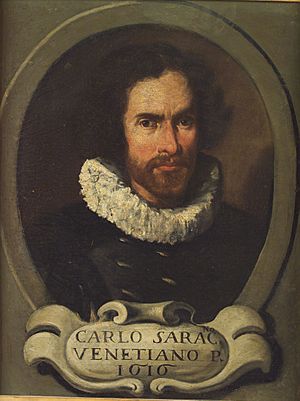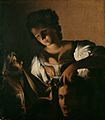Carlo Saraceni facts for kids
Quick facts for kids
Carlo Saraceni
|
|
|---|---|

Anonymous, Portrait of Carlo Saraceni (1616)
|
|
| Born | 1579 Venice
|
| Died | June 16, 1620 Venice
|
Carlo Saraceni (born 1579 – died 16 June 1620) was an Italian painter from the early Baroque period. He became known as a very good painter, especially after a detailed book about his work was published in 1968.
Contents
Life of Carlo Saraceni
Even though Carlo Saraceni was born and died in Venice, his paintings look very Roman. He moved to Rome in 1598 and joined an important art school called the Accademia di San Luca in 1607. He never went to France, but he spoke French well and had French friends and clothes.
Early Influences
At first, his paintings were influenced by Adam Elsheimer, a German painter who lived in Rome. Elsheimer was known for painting detailed landscapes with people in them. Many of Saraceni's early landscapes were even thought to be by Elsheimer!
Elsheimer also painted small pictures on copper. Saraceni used this style for several of his own works. These included six landscape panels showing The Flight of Icarus, and paintings like Moses and the Daughters of Jethro and Mars and Venus.
Caravaggio's Impact
Saraceni was also greatly influenced by Caravaggio, another famous painter. Caravaggio used dramatic lighting, large figures, and realistic details in his art. This style made Saraceni one of the first "Caravaggisti" (artists who followed Caravaggio's style). They were also called "tenebrists" because they used strong contrasts between light and dark. You can see this in Saraceni's painting Judith with the Head of Holofernes, which shows a scene lit by candlelight.
In 1606, Caravaggio's painting Death of the Virgin was not accepted for a chapel in the church of Santa Maria della Scala. Saraceni was chosen to paint a replacement, which is still there today. This painting is important because it's the only one from his first ten years in Rome that we know the exact date of.
Later Career and Return to Venice
Saraceni's painting style quickly became more developed between 1606 and 1610. In the next ten years, his work showed a mix of Caravaggio's style and the Venetian style he grew up with.
Around 1616–1617, he helped paint frescoes (wall paintings) for the Sala Regia in the Palazzo del Quirinale. In 1618, he was paid for two paintings in the church of Santa Maria dell'Anima. Some parts of his fresco The Birth of the Virgin in the church of Santa Maria in Aquiro were later used in a painting on copper that is now in the Louvre museum.
In 1620, Carlo Saraceni went back to Venice, where he passed away in the same year.
Famous Works
Here are some of Carlo Saraceni's notable paintings:
- Mars and Venus (1605–1610), oil on copper (at the São Paulo Museum of Art, São Paulo)
- Rest on the Flight into Egypt, 1606 (at Eremo dei Camaldoli, Frascati)
- The Fall of Icarus (at Museums and Art Galleries Naples, Museo e Gallerie Nazionale di Capodimonte, Naples)
- Madonna and Child with Saint Anne, painted for the Church of San Simeone Profeta, 1610 (at the Galleria Nazionale d'Arte Antica, Rome)
- Papal Authority, a chalk sketch for a fresco (at the J. Paul Getty Museum)
- Vision of Saint Francis (1615), (at the Alte Pinakothek, Munich)
- Saint Cecilia and the Angel, around 1610 (at the Galleria Nazionale d'Arte Antica, Rome)
- The Martyrdom of Saint Cecilia (at LACMA)
- The Madonna and Child with Saint Anne and an Angel oil on copper (around 1608–1610), (at the Honolulu Museum of Art)
- Nativity (at the Residenzgalerie, Salzburg)
- Carlo Borromeo Tending to Those Afflicted with Plague (at the Church of the Servi in Cesena)
You can also see Saraceni's art in the Roman church of San Lorenzo in Lucina.
Gallery
-
The Madonna and Child with Saint Anne and an Angel, oil on copper, around 1608–1610, Honolulu Museum of Art
-
Judith and the Head of Holofernes, Kunsthistorisches Museum, Vienna
See also
 In Spanish: Carlo Saraceni para niños
In Spanish: Carlo Saraceni para niños






